Ski: 2022-2023 4FRNT Hoji, 184 cm
Test Location: Mt. Crested Butte, Colorado
Days Skied: 8
Available Lengths: 177, 184, 191 cm
Blister’s Measured Tip-to-Tail Length (straight-tape pull): 182.5 cm
Stated Weight per Ski: 1990 grams
Blister’s Measured Weight per Ski: 2060 & 2075 grams
Stated Dimensions: 128-112-120 mm
Blister’s Measured Dimensions: 128.2-111.6-119.3 mm
Stated Sidecut Radius (all lengths): 30 meters
Measured Tip & Tail Splay: 73 mm / 26 mm
Measured Traditional Camber Underfoot: 0 mm
Core: aspen + maple underfoot + carbon stringers + fiberglass laminate
Base: Sintered 1.3 mm
Factory Recommended Mount Point: -6.55 cm from center; 84.7 cm from tail
Boots / Bindings / Wax: Tecnica Mach1 MV 130, Atomic Hawx Ultra 130 S GW / Salomon STH2 13 / mountainFLOW All-Temp
[Note: Our review was conducted on the 21/22 Hoji, which returns unchanged for 22/23, apart from graphics.]

Intro
The 112mm-wide Hoji has been in 4FRNT’s lineup for many, many years now, but it got overhauled for the 21/22 season — and they also added a “4-Lock” version with Eric Hjorleifson’s signature skin system.
Slotting in between the 104mm-wide Raven and 122mm-wide Renegade, the Hoji is meant to be the do-everything ski in Eric Hjorleifson’s signature series, and we’ve now been skiing it for close to a year, starting at last year’s Blister Summit and continuing through the current season (and if you want to try it yourself, you can at the 2022 Blister Summit).
What 4FRNT says about the Hoji
“Over the years you’ve seen the awards pour in for the ‘Hoji’, Eric Hjorleifson’s namesake ski, but what if we were to tell you it’s gotten even better? Eric, alongside our ski engineer and the 4FRNT Team spent this past season re-engineering the Hoji to be an even more refined powder weapon! To start, we updated the rocker profile of the ski with our signature multi radius design to give it the best balance and blend of powder performance and firm snow versatility. By slightly reducing the curvature of the rocker under foot we increased the effective edge to improve its capabilities in firm snow. At the same time, we adjusted the tip and tail height to ensure we maintained that surfy powder feel and increased its capabilities in deep snow. Next, we updated the core to Aspen/Maple with carbon fiber stringers to provide more energy and power than ever before. Whether you’re breaking trail on the skin track, picking your way through technical chutes, or slashing deep turns, you can count on the re-engineered Hoji to step up to the challenge.”
Shape / Rocker Profile
The Hoji looks a lot like the 4FRNT Raven and Renegade, with a pretty straight sidecut and notably tapered tips and tails. That’s matched with a fully reverse-cambered profile, with pretty dramatically rockered tips and tails, but a significant flat section around the bindings.
The latest Hoji features a multi-radius rocker profile, in contrast to the single-radius profile of previous versions. This is meant to make the new ski more predictable and versatile on edge, and we’d say that’s true (keep reading).
Still, for a 112mm-wide ski, the Hoji is certainly on the more tapered and more rockered end of the spectrum, by a notable margin.
Flex Pattern
Here’s how we’d characterize the flex pattern of the Hoji:
Tips: 6.5-7
Shovels: 7.5-8.5
In Front of Toe Piece: 9-10
Underfoot: 10
Behind the Heel Piece: 10-9
Tails: 8.5-7.5
The Hoji is a strong ski overall, but its tips and tails are fairly soft. It’s a bit softer through the shovels than the 4FRNT Raven, but stiffer through the tails. Overall, the Raven, Hoji, and Renegade all feel pretty similar in terms of flex pattern, with soft tips, slightly stiffer tails, and a considerable stiff section around the middle of the skis.
Sidecut Radius
The Hoji’s stated sidecut radius is 30 meters across all three lengths. That’s very long when compared to other skis in its class, though not super out of the ordinary for a soft-snow-oriented, reverse-camber ski.
Mount Point
Similar to Eric Hjorleifson’s other signature skis, the Hoji’s recommended mount point is pretty progressive. At about -6.5 cm from true center, the Hoji’s recommended mount point is notably closer to the center than most skis, but not as close to center as some freestyle-oriented skis, such as the 4FRNT Devastator.
Weight
For how wide it is, the Hoji is pretty light. Our pair of the 184 cm Hoji came in at about 2067 grams per ski, which puts it a bit heavier than some touring-specific skis, but lighter than many resort-specific skis. As a result, it has the potential to work for skiers in both categories (more on that later).
For reference, here are a number of our measured weights (per ski in grams) for some notable skis. Keep in mind the length differences to try to keep things apples-to-apples.
1800 & 1804 Head Kore 105, 184 cm (21/22)
1806 & 1862 Armada Tracer 108, 180 cm (19/20–21/22)
1820 & 1821 Majesty Havoc, 186 cm (20/21–21/22)
1850 & 1886 Head Kore 111, 184 cm (21/22)
1863 & 1872 Atomic Bent 110, 188 cm (22/23)
1875 & 1881 Line Sir Francis Bacon, 184 cm (19/20–22/23)
1895 & 1906 Folsom Trophy Carbon, 188 cm (18/19–21/22)
1905 & 1919 J Skis Slacker, 188 cm (20/21–21/22)
1920 & 2006 RMU North Shore YLE 110, 186 cm (21/22)
1947 & 2011 4FRNT Devastator, 186 cm (20/21–21/22)
1951 & 1953 Elan Ripstick 106, 188 cm (20/21–22/23)
1951 & 1957 RMU Apostle 3.0 106 Wood, 184 cm (21/22)
1964 & 1972 Moment Deathwish, 184 cm (19/20–20/21)
1970 & 1973 4FRNT Renegade, 184 cm (20/21–21/22)
1970 & 1993 Moment Deathwish 104, 184 cm (21/22)
1993 & 2026 Black Crows Atris, 184.2 cm (19/20–21/22)
2008 & 2065 Wagner Summit 106, 186 cm (20/21–21/22)
2011 & 2028 Moment Wildcat 108, 184 cm (19/20–20/21)
2011 & 2046 Elan Ripstick 106 Black Edition, 188 cm (21/22–22/23)
2027 & 2052 K2 Reckoner 112, 184 cm (20/21–22/23)
2034 & 2052 Blizzard Rustler 11, 188 cm (17/18–21/22)
2046 & 2120 Black Crows Corvus, 188 cm (18/19–21/22)
2060 & 2075 4FRNT Hoji, 184 cm (21/22)
2096 & 2100 Salomon QST 106, 181 cm (19/20–21/22)
2110 & 2119 Moment Wildcat 108, 190 cm (19/20–20/21)
2112 & 2125 4FRNT MSP 107, 187 cm (18/19–21/22)
2116 & 2181 Faction Dictator 3.0, 188 cm (19/20–21/22)
2145 & 2167 Sego Big Horn 106, 187 cm (20/21)
2153 & 2184 Rossignol BLACKOPS Sender Ti, 187 cm (20/21–21/22)
2165 & 2211 K2 Mindbender 108Ti, 186 cm (19/20–21/22)
2165 & 2219 Icelantic Nomad 105, 191 cm (19/20–20/21)
2170 & 2180 Dynastar M-Free 108, 182 cm (20/21–21/22)
2182 & 2218 Nordica Enforcer 110 Free, 185 cm (17/18–22/23)
2228 & 2270 Sego Comp 110, 187 cm (20/21–21/22)
2232 & 2242 Blizzard Cochise 106, 185 cm (20/21–21/22)
2243 & 2287 Salomon QST Blank, 186 cm (21/22-22/23)
2295 & 2344 J Skis Hotshot, 183 cm (20/21–21/22)
2302 & 2342 Dynastar M-Free 108, 192 cm (20/21–21/22)
2312 & 2386 Prior Husume, 188 cm (17/18–21/22)
2353 & 2360 Volkl Katana 108, 184 cm (20/21–21/22)
2449 & 2493 J Skis Hotshot, 189 cm (20/21–21/22)
Now, onto how the Hoji performs on snow:
FULL REVIEW
Powder & Soft Chop
Luke Koppa (5’8”, 155 lbs / 173 cm, 70 kg): Overall, the Hoji feels most at home in soft snow. And in conditions that are both soft and somewhat deep (6 in +), it’s a blast.
In these conditions, the Hoji feels very similar to the 4FRNT Renegade that we reviewed earlier this season. The two share a lot in common, especially in softer snow. The Hoji obviously doesn’t offer quite as much flotation, but I frankly never got the Hoji in deep enough conditions where that mattered (max depth during my time on it was about a foot). I’d say the Hoji floats better than most ~112mm-wide skis. But more notably, it’s similar to the Renegade in terms of how easy it is to release and slarve, making it easy to shed speed and/or change direction when you need.
That meant I really came to love the Hoji on soft days when I was in terrain with lots of features and undulations, since it let me make decisions on the fly and I never felt like I needed to be fully committed to a specific line, knowing I could always make a last-second change on this ski.
In powder, the Hoji prefers a fairly centered stance, but as in other conditions, I can also drive it through the shovels a bit when I need to.
When the fresh snow gets cut up, the Hoji offers an impressive level of stability and composure, given how little it weighs. It doesn’t just blast through patches of pushed-around snow like much heavier skis can, but especially if I stayed light on my feet, I was able to ski very fast on the Hoji when conditions were soft and choppy.
Same as in untouched snow, the Hoji’s ability to easily pivot at a moment’s notice is a benefit in chop. Given that it’s a ski that encourages a dynamic style (similar to Mr. Hjorleifson himself), it helps that the Hoji ski makes it easy to quickly shed speed or change direction, since that inevitably happens to me when I’m trying to both ski fast and make lots of slashes, get in the air often, etc.
Dylan Wood (5’10”, 155 lbs / 178 cm, 70 kg): Luke hit the main points. I had the pleasure of skiing the Hoji during our crazy late-December and early-January storm cycle where we received over 8 feet of snow in a little over a week. On the particular day I skied it, Mt. Crested Butte had reported 10”, and I found the Hoji more than adequate in these conditions.
The Hoji does float quite well in deep snow for a ~112 mm wide ski, but I don’t think its pure flotation is what’s most impressive about this ski in powder. What strikes me as most impressive is just how loose and easy to maneuver the Hoji is in powder. I found that it didn’t take much input to throw this ski sideways as long as I was traveling at moderate speeds or faster (say, 10+ mph); I felt like I could just flick the Hoji around from my ankles in soft snow. Not only this, but I could also throw the Hoji into controlled high-speed drifts, and it could just remain perpendicular to the fall line for an absurd amount of time (long enough to make me feel like McConkey).
The Hoji definitely isn’t just for making big, drifted turns in open terrain. Its maneuverable and easy-to-pivot ride also very much comes in handy in tight, unpredictable terrain, as Luke mentioned. I found myself taking a lot of speed into tight trees, knowing that I could pivot and flick the Hoji around to redirect myself to where there wasn’t a small tree coming at me.
I also found the Hoji to be comfortable and complaint with a centered stance, but I could definitely put some force into its shovels, especially in steeper terrain where I am spending a lot of time with my skis sideways. I don’t think the Hoji would be my first recommendation for a very directional skier who is used to very traditional (-10 cm or farther back) mount point and puts (or wants to put) a lot of weight on the shovels of their skis in powder. But for many people, I think the Hoji will feel pretty versatile in terms of stance.
Firm Chop / Crud
Luke: As I alluded to up top, the Hoji feels best when conditions are fairly soft. It’s still a lot of fun at the end of a resort powder day when you’re dealing with firmer, more consolidated chop, but it feels pretty out of place in, say, fully refrozen conditions.
On one hand, I think the Hoji offers really good suspension, given its low weight for its size. On the other hand, it’s still a pretty lightweight ski, and a reverse-cambered one. Especially underfoot, the Hoji can feel a bit harsher on super rough conditions than cambered skis of a similar weight.
So, at least for me, the Hoji encourages a pretty conservative approach when conditions are truly nasty. Fortunately, its reverse camber profile makes it easy to slash around turns at moderate speeds as I make my way to better conditions. And in firm, but fairly consistent conditions, I was still pretty happily skiing pretty fast on the Hoji, given that I knew I could throw it sideways when I needed to shed speed.
Dylan: Yeah, the Hoji does feel pretty harsh underfoot in very firm conditions. Recently, we got some new snowfall on top of some firm snow that is refrozen in places, and whenever I encountered a scraped-off section with ultra-firm snow underneath, I could definitely feel just how firm the snow was through the Hoji.
When firm conditions are more forgiving, like smooth chalk, I really had no issues with the Hoji and found that it slid its way through these conditions in a predictable manner. Still, in steep and firm conditions where your skis can sometimes end up “skipping” on the snow when sliding downhill sideways, the underfoot section of the Hoji feels very stiff (I suspect both longitudinally and torsionally; we’ll see with the help of the Blister Labs program), and it directs a lot of whats happening right to your boots. I don’t want to put too much significance on this, I think it’s just that the Hoji isn’t really designed for such conditions, which is totally reasonable given that the Hoji can make it through such scenarios with little drama so long as you don’t ski like you’re on a 2400-gram ski.
Moguls, Trees, & Tight Terrain
Luke: I really, really like this ski in tight terrain. Similar to both the 4FRNT Raven and Renegade, the Hoji’s easy-to-pivot nature makes it pretty easy to maneuver through tight spots, especially considering how stable it feels at high speeds in soft-ish conditions.
If I stay centered or forward, the Hoji requires very little effort to release and pivot in tight bumps and trees. One thing I noticed is that, on firm conditions, the Hoji’s tail could dig in more than I expected when I got really backseat, making it a bit difficult to recover. But to be clear: this was on firm conditions, and when I was very backseat. If one of those two things was not happening, the Hoji remained super easy to pivot. But if you’ll be breaking out this ski when it hasn’t snowed in a long time, just try to stay balanced and/or over the shovels.
That caveat aside, the Hoji is one of my favorite ~110mm-wide skis for skiing in tight terrain that requires lots of turns and adjustments — especially if the snow is somewhat soft. It feels very quick, maneuverable, and playful, with a progressive mount point that just begs me to get the ski in the air at any opportunity (even if it’s a small air).
Dylan: I don’t have much to add here other than echoing Luke’s thoughts; the Hoji is a really great tool for navigating tight terrain, whether that be big moguls or tight trees. Despite being so tapered, I also did find its tails can be a bit punishing when making a backseat turn in tight terrain. I think this might go back to how torsionally stiff this ski feels, and I will also agree that this was a non-issue in soft snow.
Groomers
Luke: The Hoji is 112 mm wide, reverse cambered, and has a 30-meter sidecut radius. None of those things are typically what we see on great piste skis.
However, the Hoji has proven very predictable on groomed snow. On firm conditions, its sidecut radius feels a lot shorter than it is on paper, and in a good way. While I don’t get much engagement from its tapered tips, I can comfortably carve big GS to Super G turns on it, mostly from the center of the ski. I also found its edge hold to be pretty impressive, with a reliably grippy platform underfoot.
In sum: don’t buy the Hoji if you want to carve super hard on your ~110mm-wide ski. But if you mostly want to get down firm and soft groomers in a predictable manner on a ski this wide, the Hoji does just fine.
Dylan: I think the Hoji surprised me the most on groomers. I wasn’t expecting much out of it, but I did find that I could carve it pretty hard, even on scraped-off groomers. You definitely don’t get much, if any, engagement or turn initiation out of the Hoji’s tips or shovels; it kind of just feels like you’re carving on the area of the ski underfoot and ~25 cm in front of and behind the bindings. However, this section of ski felt really strong and again, (I suspect) very torsionally stiff, resulting in surprisingly good edge hold.
Don’t get me wrong, though, this definitely isn’t a ski for people looking to carve hard and/or tight turns on their ~110 mm wide skis. But if you’re okay with just slarving your way back to the lift or making only one turn where you’d usually make 2 or 3 (at about twice the speed, too), the Hoji should fulfill your groomer needs as you make your way to some soft, off-piste terrain.
Playfulness
Luke: Like the 4FRNT Renegade and Raven, the Hoji feels like a very playful ski, but not necessarily a freestyle-oriented one.
The Hoji is super easy to slash and throw sideways, it lets you ski centered, and it feels balanced in the air. But it’s also not super poppy, easy to bend, or great for skiing switch.
Personally, as someone who doesn’t spin, flip, or ski switch a whole lot, the Hoji is plenty playful for me — it lets me ski in the “playfully directional” style that I prefer. But if freestyle performance is a priority for you, the 4FRNT Devastator probably makes more sense.
Dylan: “Playfully directional” sums up the Hoji very well. It’s easy to slash, feels balanced when spinning and flipping, and caters well to an upright and centered stance. I wouldn’t be very inspired to try buttering this ski around everywhere or landing switch off anything big or into moderately deep/soft snow, though.
Who’s It For?
Luke: There are several different types of skiers who I think could appreciate the Hoji.
First and foremost are those who split their time between the backcountry and resort, and are looking for a soft-snow ski to use for both. The Hoji is damp and stable enough in soft conditions that I think it feels at home in resort conditions, but it’s light enough to not feel like some massive burden on a skin track. Plus, it deals with weird backcountry conditions (crusts, sastrugi, dense snow) better than most. It’s not a great carver, nor the best 110mm-wide ski on firm conditions, but it should be especially appealing to those who value maneuverability, a balanced ride, and the ability to quickly change directions (on the snow and in the air).
The Hoji could also work as a resort-specific pow ski. We’ve never felt like it was lacking in flotation (in snow up to around a foot), and its stability for its weight is good enough that many folks who ski with an active, light-on-their-feet style will be able to ski very fast on it in soft chop. It should be particularly appealing to those who like to search for soft snow in tight terrain, due to its impressive maneuverability.
On the other hand, the Hoji could serve as a dedicated touring ski, provided that you’re someone who prioritizes stability over low weight. There are lighter alternatives around this width, but I personally wouldn’t be very hesitant to do some big days of skinning on the Hoji — provided that all that skinning got me to the top of some steep terrain, ideally with lots of features to pop around on.
Bottom Line
The latest 4FRNT Hoji now feels like a logical middle ground in Eric Hjorleifson’s signature series. It’s far more versatile in non-deep conditions than the Renegade, but it floats, drifts, and slashes soft snow better than the Raven. The Hoji’s moderately low weight makes it a viable option for human-powered skiing, yet it’s stable enough in somewhat soft conditions that lots of resort skiers have reason to check it out, too.
Deep Dive Comparisons
Become a Blister Member or Deep Dive subscriber to check out our Deep Dive comparisons of the Hoji to see how it compares to the 4FRNT Renegade, 4FRNT Raven, 4FRNT Devastator, Black Crows Corvus, Salomon QST Blank, 4FRNT Inthayne, Black Crows Anima, Line Vision 118, K2 Reckoner 112, Moment Deathwish, J Skis Friend, Wagner Summit 106, Head Kore 111, RMU YLE 110, Sego Comp 110, Icelantic Nomad 105, Nordica Enforcer 110 Free, and J Skis Slacker.

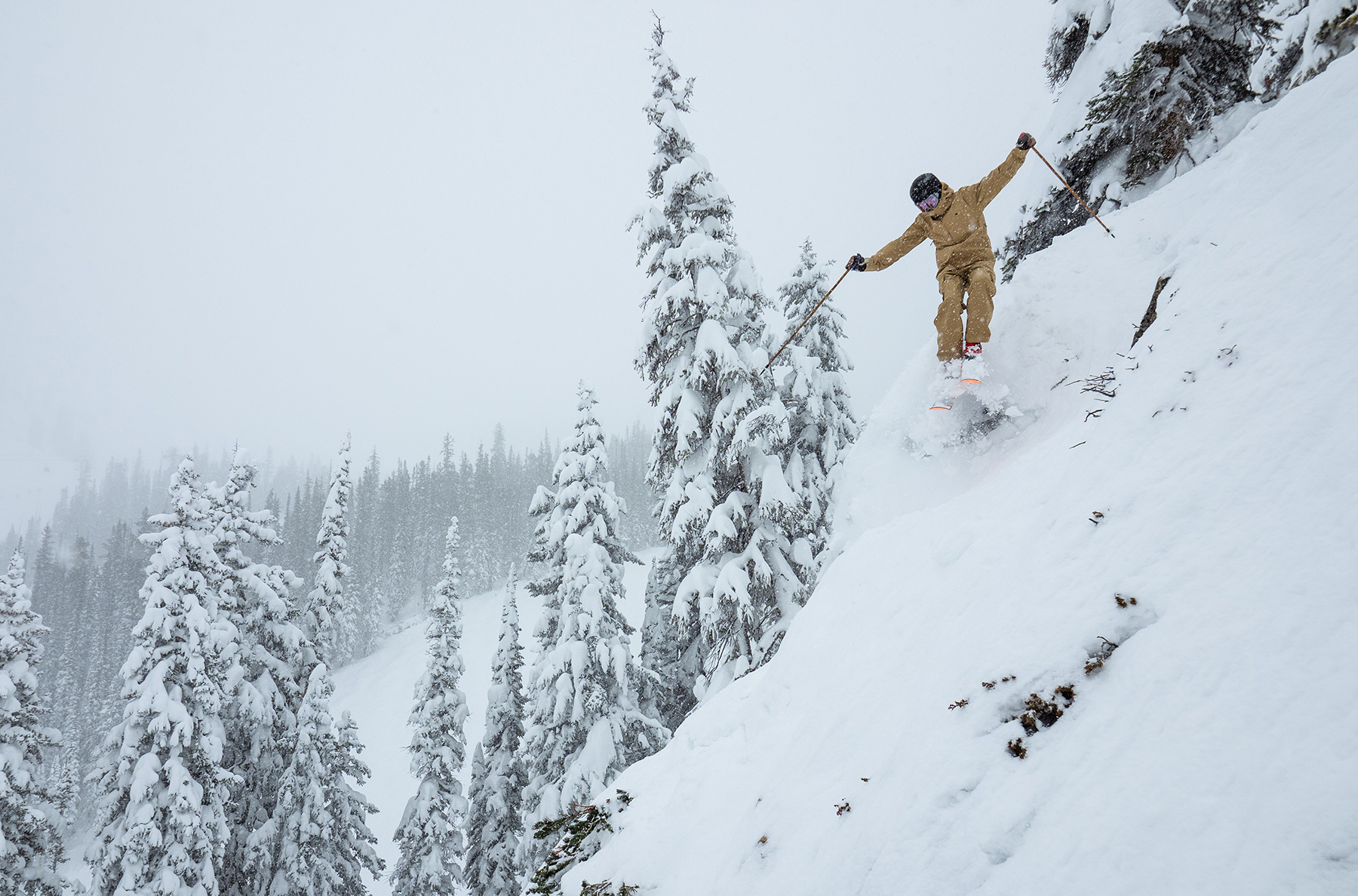


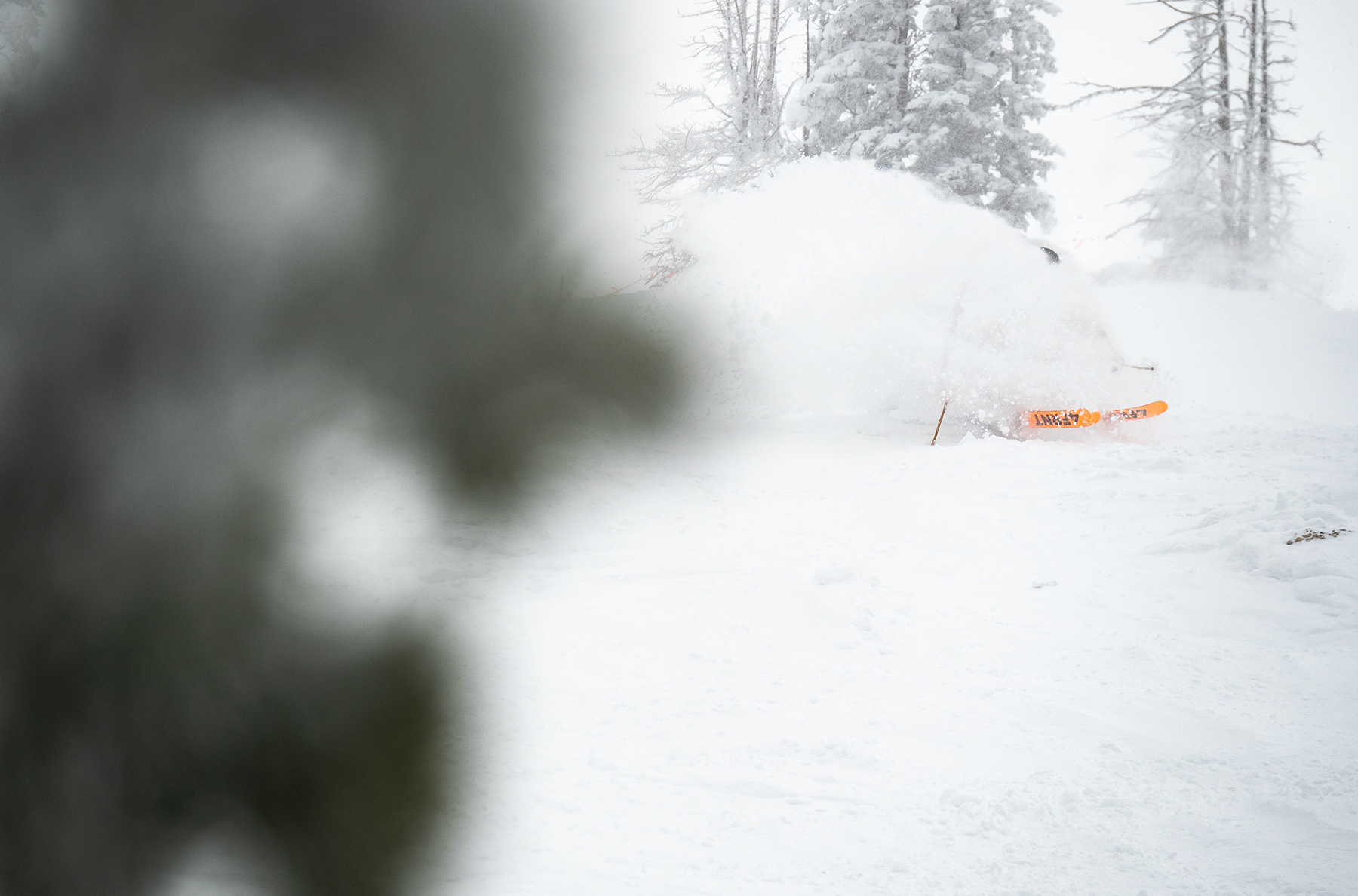
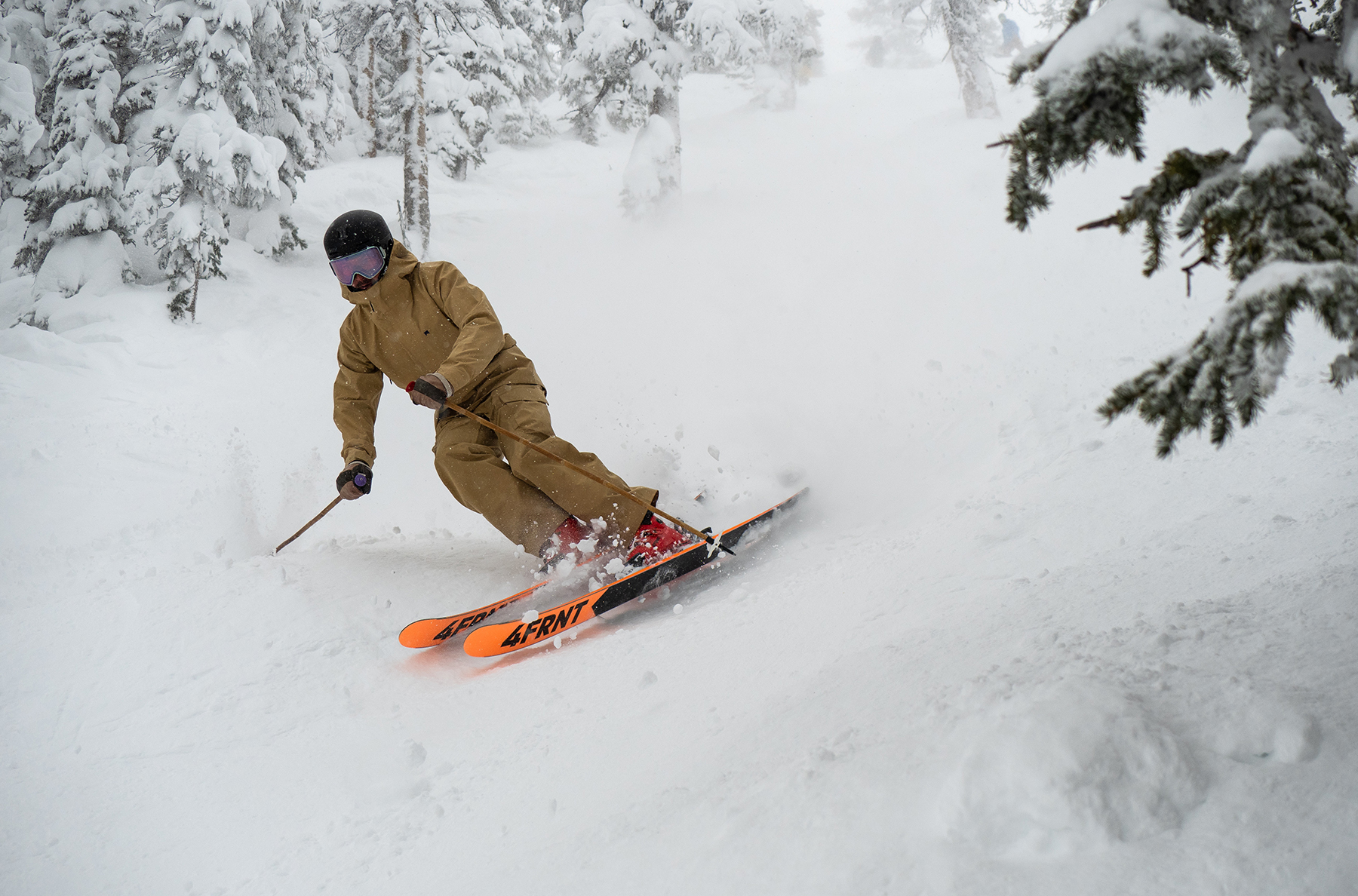
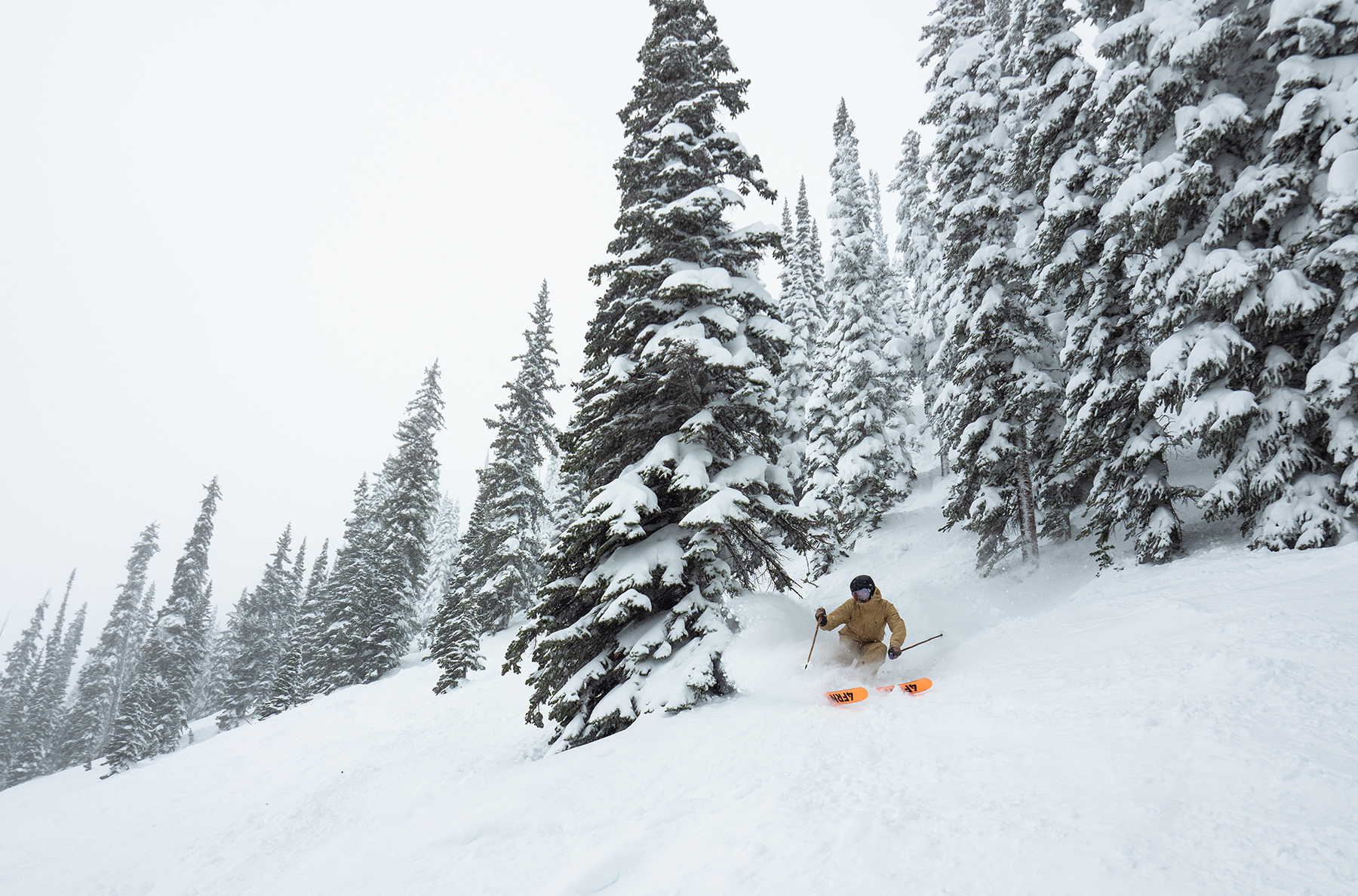
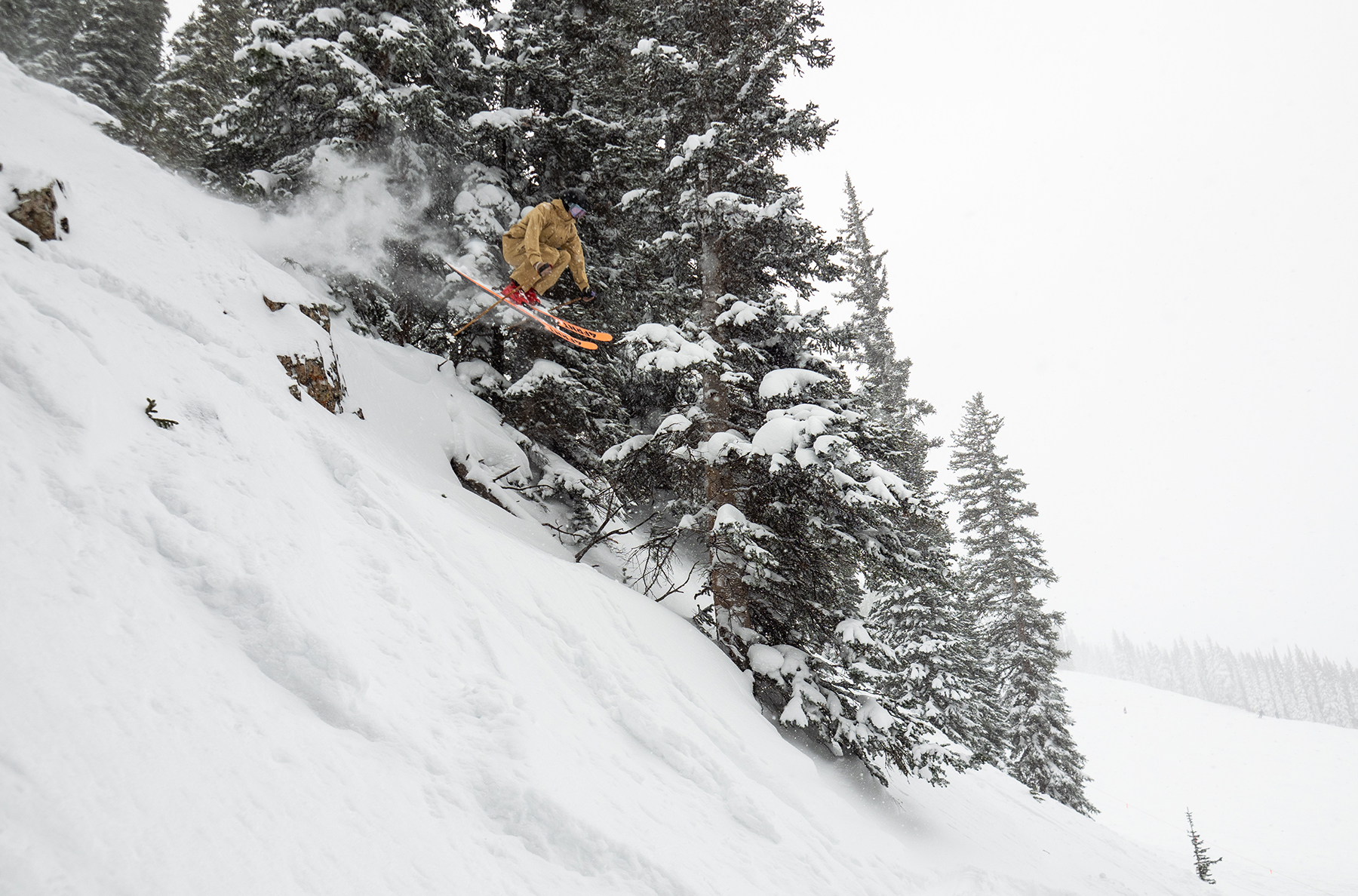
How does the mount point feel? Could there be value in mounting the ski back a centimeter or 2 from recommended?
Apologies for missing this, but all of us felt quite happy with the recommended mount point (directional and more playful reviewers alike), where we could ski it quite centered, especially in softer snow, but then drive it pretty hard on firmer and more variable conditions. I suppose you could gain some flotation and support from the shovels if you moved the bindings back a cm or two, but especially since the Hoji’s rocker profile and sidecut are designed to match around the recommended mount point, and because we found that mount point quite versatile in terms of stance, I wouldn’t be super inclined to stray very far from that recommended line.
Same question as Lwtargett.
Same question as bounce
I did mount my Hoji back by 1cm and my Raven even 1.5cm and they both work much better for me than they did on the recommended mounting point, sending me nose-diving a couple of times until I got the hang of the Raven. But I am used to directional skis with larger setbacks and I am a forward-oriented skier, liking that better. Hope this input helps.
I have the older version of the Hoji in 187 and now the newer one in 184. Personally I prefer the older 187, the newer one is maybe slightly better on groomers, but dosnt float as well as the old version and isn’t even close to being as surfy and quick as the old version. I really wish Hoji hadn’t listen to Jonathan whining about the old one and left it alone, another great ski reduced to just average because of someone who couldn’t handle it, great job blister
Ha, this is some wild trolling coupled with unfounded insults from someone who provides no details that might leave you to believe that they’re good at assessing skis, or understand how skis work. (You realize, right, that Dylan and Luke wrote this particular review?) Great stuff.
This is actual the comment I was hoping to find on this review actually. I have the older model and love it for the reasons Billy stated. I too am sad to have lost that surfy loose feeling ski. Seeing the words “now fits the character of the Raven and the Renegade” makes me sad. What was so great about the previous Hoji model was that it was unique in character not just waist width. Now it seems the Hoji line only differs by waist and I think that is pretty tragic.
And Hoji endorsing a cambered skinny ski? What is happening!
And I guess in your mind you feel your more then qualified to review skis, are you a ex pro, NO, have you qualified for the Freeride world tour,NO, then what makes you think you are qualified to review skis, just because your fellow kooks stroke your huge ego, you think you are the end all to ski reviews, your just another kook in a long line of kooks, And yes I have skied the FRWT, and I stand by my original comment 2 years ago that the original Hoji Kicked your ASS outside of powder, your huge ego was hurt so you whined to Hoji
Props to the Blister crew here for posting these disrespectful opinions and claims on their own platform. Something tells me Hoji would be incredibly insulted if anyone thought he would compromise his product and name to please skiers using things outside their intended use It’s also sad to hear this rhetoric from a tour pro…?